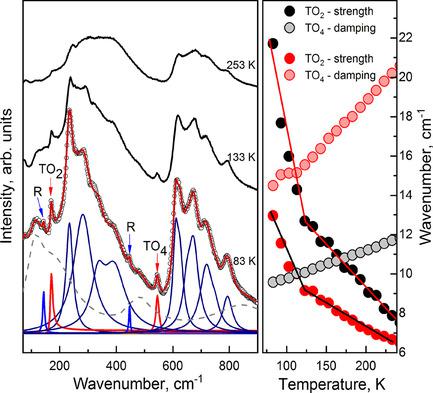当前位置:
X-MOL 学术
›
Phys. Status Solidi B
›
论文详情
Our official English website, www.x-mol.net, welcomes your feedback! (Note: you will need to create a separate account there.)
Crystal Structure and the Spectral Response of the Ba-Doped SrTiO3 Incipient Ferroelectrics
Physica Status Solidi (B) - Basic Solid State Physics ( IF 1.6 ) Pub Date : 2021-04-29 , DOI: 10.1002/pssb.202100010 Ekaterina D. Linnik 1, 2 , Igor A. Lukyanchuk 1, 2 , Alexey S. Mikheykin 1 , Andrey V. Ragulya 3 , Boris P. Gorshunov 4 , Liudmila N. Alyabyeva 4 , Sergey S. Zhukov 4 , Daoud Mezzane 2, 5 , Anna G. Razumnaya 1
Physica Status Solidi (B) - Basic Solid State Physics ( IF 1.6 ) Pub Date : 2021-04-29 , DOI: 10.1002/pssb.202100010 Ekaterina D. Linnik 1, 2 , Igor A. Lukyanchuk 1, 2 , Alexey S. Mikheykin 1 , Andrey V. Ragulya 3 , Boris P. Gorshunov 4 , Liudmila N. Alyabyeva 4 , Sergey S. Zhukov 4 , Daoud Mezzane 2, 5 , Anna G. Razumnaya 1
Affiliation

|
The crystal structure and lattice dynamics of quantum paraelectric BaxSr1−xTiO3 (x = 0, 0.01, 0.02) solid solutions are studied using X-ray diffraction (XRD), Raman and terahertz-infrared (THz-IR) spectroscopies in a temperature range of 4–300 K. XRD and Raman spectroscopy reveal the cubic-to-tetragonal nonpolar structural phase transition at about 100 K. At the same time, Raman spectra manifest the presence of polar modes, TO2 and TO4, normally prohibited in paraelectric phase. Emergence of these modes indicates the appearance of the polar nanoregions in a broad temperature range. The modes become more intensive at low temperatures, and temperature dependence of their intensities on cooling reveals the kink-like change of the slope from flat to steep, indicating on activation of polar nanoregions. The transmission THz-IR spectra show that squared frequency of the polar TO1 soft mode, responsible for ferroelectric transition, follows Cochran's behavior at high temperatures. However, at low temperatures, it doesn't vanish at extrapolated Curie temperature but saturates, demonstrating the plateau feature below 20 K. This behavior, coherent with known saturation of the dielectric constant, indicates that transition to ferroelectric phase in BaxSr1−xTiO3 is suppressed by quantum fluctuations and the system stays in quantum paraelectric state at very low temperatures.
中文翻译:

掺钡 SrTiO3 初期铁电体的晶体结构和光谱响应
使用 X 射线衍射 (XRD)、拉曼和太赫兹红外 (THz-IR) 光谱研究了量子顺电 Ba x Sr 1− x TiO 3 ( x = 0, 0.01, 0.02) 固溶体的晶体结构和晶格动力学在 4-300 K 的温度范围内。XRD 和拉曼光谱揭示了立方到四方非极性结构相变在大约 100 K。同时,拉曼光谱表明存在极性模式,TO 2和 TO 4,通常禁止在顺电阶段。这些模式的出现表明在很宽的温度范围内出现了极性纳米区域。模式在低温下变得更加密集,并且它们的强度对冷却的温度依赖性揭示了斜率从平坦到陡峭的扭结状变化,表明极性纳米区域的激活。透射太赫兹-红外光谱表明,负责铁电转变的极性 TO 1软模式的平方频率遵循 Cochran 在高温下的行为。然而,在低温下,它不会在外推居里温度下消失,而是饱和,表明低于 20 K 的平台特征。这种行为与已知的介电常数饱和一致,x Sr 1− x TiO 3受到量子涨落的抑制,系统在极低温度下保持量子顺电态。
更新日期:2021-04-29
中文翻译:

掺钡 SrTiO3 初期铁电体的晶体结构和光谱响应
使用 X 射线衍射 (XRD)、拉曼和太赫兹红外 (THz-IR) 光谱研究了量子顺电 Ba x Sr 1− x TiO 3 ( x = 0, 0.01, 0.02) 固溶体的晶体结构和晶格动力学在 4-300 K 的温度范围内。XRD 和拉曼光谱揭示了立方到四方非极性结构相变在大约 100 K。同时,拉曼光谱表明存在极性模式,TO 2和 TO 4,通常禁止在顺电阶段。这些模式的出现表明在很宽的温度范围内出现了极性纳米区域。模式在低温下变得更加密集,并且它们的强度对冷却的温度依赖性揭示了斜率从平坦到陡峭的扭结状变化,表明极性纳米区域的激活。透射太赫兹-红外光谱表明,负责铁电转变的极性 TO 1软模式的平方频率遵循 Cochran 在高温下的行为。然而,在低温下,它不会在外推居里温度下消失,而是饱和,表明低于 20 K 的平台特征。这种行为与已知的介电常数饱和一致,x Sr 1− x TiO 3受到量子涨落的抑制,系统在极低温度下保持量子顺电态。



























 京公网安备 11010802027423号
京公网安备 11010802027423号